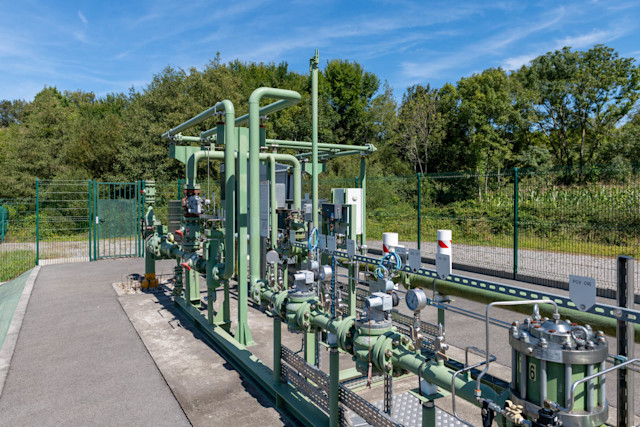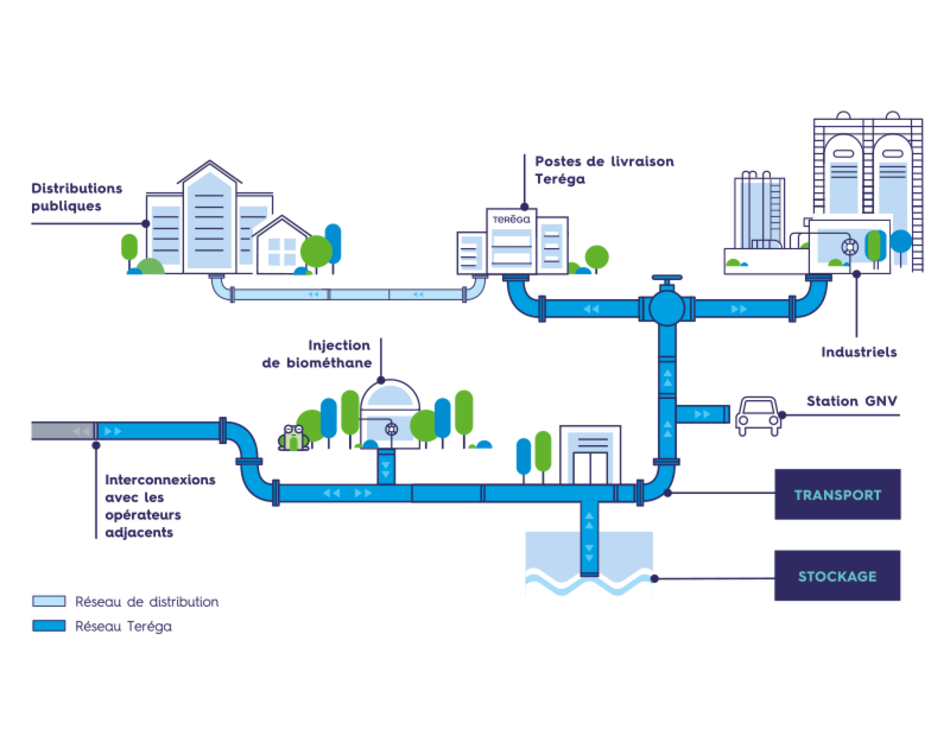Urgence gaz 0 800 028 800

Connection to the gas grid: teréga’s customer focus
Delivery to customers connected to the our gas grid accounts for about a third of the total quantities transported. This arrangement involves nearly 325 supply points. We design the connection as an integral part of the service we offer using our Transport expertise.
What is connection to the teréga gas grid?
This is a physical connection to our transport grid. The connection is dedicated exclusively to the consumer customer or the distribution grid manager (GRD). As a true extension to our transport grid, it comprises a number of assemblies:
A branch line. This is a pipeline between our grid and the supply point.
one or more supply points. Located at the consumer’s site or near the network being supplied, their purpose is to meter the gas and deliver it at the requested pressure;
one or more injection points. This applies only to gas production (biomethane) sites. Located near the production site, their purpose is to meter, to check the quality of the gas, and to inject it at network pressure.
Equipment
The connection is therefore a set of equipment (spur and supply/injection point) which fulfils the functions of:
connection;
metering;
pressure regulation;
protection of the customer’s network against overpressure.

When renewable energy and connection go hand in hand with Teréga
There are two main categories of customer who benefit from connection to our gas grid. On the one hand there are industries consuming gas themselves for their own activities. On the other hand there are public distribution grid managers, who then distribute the gas to private individuals, businesses etc.
Committed to energy transition, we are developing our grid to speed up the exploitation of green gases. Most notably we construct the biomethane injection and testing infrastructure, along with the connection to the gas transport grid. For producers – farmers, food industry, water treatment plants etc. – the injection of biomethane into the grid allows them to generate additional income by selling what they produce. Biomethane is a renewable energy source recovered through the recycling of household, organic agricultural or food industry waste, and helps reduce greenhouse gases (GHGs).
In addition, we are also developing a Natural Gas Vehicle (NGV/BioNGV) station connection offer to support new uses across local authorities, hauliers, filling stations, industry, private individuals etc.
At Teréga, connection to the gas grid means providing a service
Connection is part of our job as a gas transporter and we have acquired great expertise in the field through that work, providing a range of specialist services. These include:
provision of the connection;
its operation and maintenance;
safety management for structures, particularly in respect of earthworks by third parties in the vicinity;
a number of additional associated services.
The connection, which is owned by Teréga, can be installed on land belonging to third parties or to the end customer (industry, distribution grid manager, injector), with whom we sign an easement agreement. In addition, the customer contributes to the costs of designing, operating and maintaining that connection, as well as the supply of any other additional services: pressurisation offer, gas heating or analysis etc.). We act as guarantors of the continuity of the gas supply on behalf of shippers. This is part of our public service mission (Order 2004-251).
Combined cycle gas turbine (CCGT) power plants, another combination
A CCGT brings together two different types of turbine: one gas-powered, the other steam-driven, thus producing electricity. This type of power plant comprises one or two units, each rated at around 400 MW. CCGTs have specific modulation requirements, associated with the overflow needed by the plant when it is operating.
We therefore provide a suitable connection service to the main grid, with specific resources in terms of personnel, IT and infrastructure (compression etc.). Capacity is determined using the power plant’s consumption profile and modulation requirements.
Making a connection to teréga’s gas transport grid
We do not cover the gas supply service. To buy or sell gas, the connected consumer customer should therefore contact the supplier of their choice, who must hold a ministerial supply authorisation. That supplier can sign a transport contract with us. By virtue of that, they are deemed to be a transport shipper.
Our transport contract allows the routing of gas between the place where it is made available – at the entry point into our grid – and the place of consumption or delivery to a distribution grid.
In addition, the metering of the gas at the supply/injection points is transactional. An approved service provider carries out period metrological verifications, under the control of the DIRECCTE (regional department of enterprise, competition, consumer affairs, labour and employment). The DIRECCTE satisfies itself that the installations are compliant for determining the quantities of gas passing through on behalf of the shippers.
The Teréga ecosystem

Safety: our priority in the connection phase
We subject the gas grid connection to the same safety rules as other transport structures. That requirement applies to its design, construction, operation and maintenance. We therefore make sure there is continuous monitoring of this equipment to guarantee its integrity and proper operation.
Ensuring there is unfailing safety and reliability is one of our major commitments as a responsible actor in the gas industry. In addition, as part of our continuous innovation process, the R&I division is constantly developing new performance and safety techniques. They are centred on two main concepts: monitoring and anticipation.






